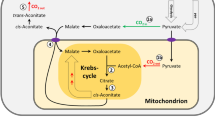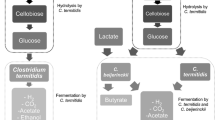Abstract
Co-cultures of N. frontalis with a formate-utilizing methanogen, Methanobacterium formicicum and/or an aceticlastic methanogen, Methanosaeta concilii, were performed for methane production from cellulose. In the co-culture with M. formicicum, ca. 16 mM CH4 was produced after 7 days without accumulation of H2 and formate. In the co-culture with M. concilii, 12 mM CH4 was produced after 17 days with decreasing acetate production. In the tri-culture of N. frontalis with M. formicicum and M. concilii, 24 mM CH4 was produced after 17 days where acetate still remained at 23 mM, but production of lactate and ethanol decreased. When a 4-times concentrated culture broth of M. concilii was inoculated in this tri-culture system in a bioreactor, 150 mM CH4 was produced after 24 days by feeding of cellulose, although 57 mM acetate still accumulated.
Similar content being viewed by others
References
Bauchop T, Mountfort DO (1981) Cellulose fermentation by a rumen anaerobic fungus in both the absence and the presence of rumen methanogens. Appl. Environ. Microbiol. 42: 1103–1110.
Fukuzaki S, Chang Y-J, Nishio N, Nagai S (1991) Characterization of granular methanogenic sludge grown on lactate in a UASB reactor. J. Ferment. Bioeng. 72: 465–472.
Fukuzaki S, Nishio N, Nagai S (1995) High rate performance and characterization of granular methanogenic sludges in up-flow anaerobic sludge blanket reactors fed with various defined substrate. J. Ferment. Bioeng. 79: 354–359.
Nishio N, Kayawake E, Nagai S (1985) Rapid methane production fromformate or acetate in fixed bed bioreactors. J. Ferment. Technol. 63: 205–209.
Pette KC, Versprille AI (1982) Application of the UASB-concept for wastewater treatment. In: Anaerobic Digestion 1981. Amsterdam: Elsevier/North-Holland Biochemical Press, pp. 121–137.
Teunissen MJ, Huub JM, Op den Camp HJM, Oripin CG, Huis in't Veld JHJ, Vogels GD (1991) Comparison of growth characteristics of anaerobic fungi isolated from ruminant and nonruminant herbivores during cultivation in a defined medium. J. Gen. Microbiol. 137: 1401–1408.
Teunissen MJ, Kets EPW, Op den Camp HJM, Huis in't Veld JHJ, Vogels GD (1992a) Effect of coculture of anaerobic fungi isolated from ruminants and non-ruminants with methanogenic bacteria on cellulolytic and xylanolitic enzyme activities. Arch. Microbiol. 157: 176–182.
Teunissen MJ, Baerends RJS, Knelissen RAG, Op den Camp HJM, Vogels GD (1992b) A semi-continuous culture system for production of cellulolytic and xylanolytic enzymes by the anaerobic fungus Piromyces sp. strain E2. Appl. Microbiol. Biotechnol. 38: 28–33.
Theodorou MK, Davies DR, Orpin CG (1994) Nutrition and survival of anaerobic fungi. In: Mounfort DO, Orpin CG, eds. Anaerobic Fungi (Biology, Ecology, and Function). Marcel Dekker, Inc., pp. 107–128.
Author information
Authors and Affiliations
Rights and permissions
About this article
Cite this article
Nakashimada, Y., Srinivasan, K., Murakami, M. et al. Direct conversion of cellulose to methane by anaerobic fungus Neocallimastix frontalis and defined methanogens. Biotechnology Letters 22, 223–227 (2000). https://doi.org/10.1023/A:1005666428494
Issue Date:
DOI: https://doi.org/10.1023/A:1005666428494




